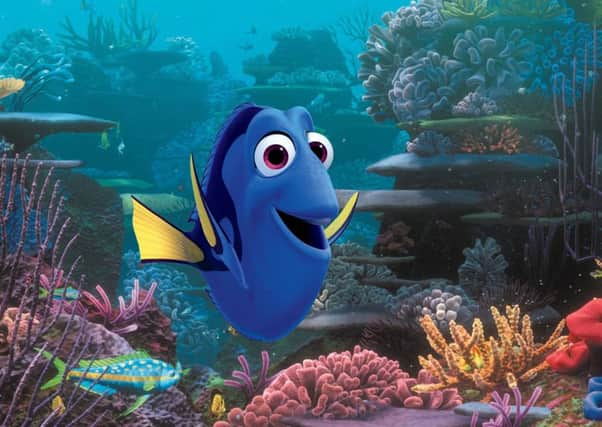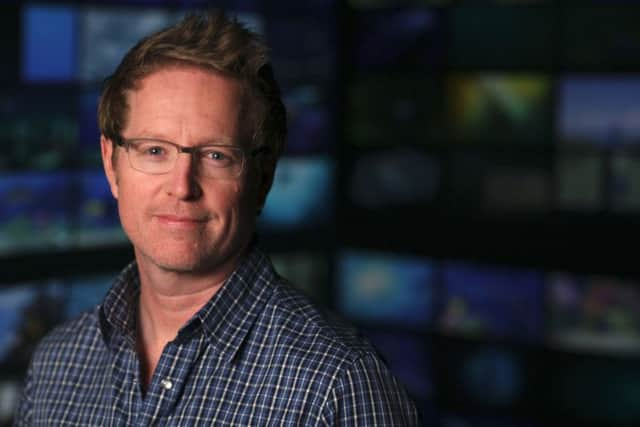Pixar director Andrew Stanton on finding a story for Dory


One might think that making a belated sequel to one of the most beloved family films of recent years would put a lot of pressure on a filmmaker. But if Andrew Stanton felt nervous about revisiting the world of Finding Nemo 13 years after his directorial debut became not only Pixar’s first Oscar winner for best animated film, but also the studio’s highest grossing movie until Toy Story 3, he isn’t letting on. “To be honest, every film we’ve made seems to have this pressure because it’s the next Pixar film,” chuckles Stanton, who in addition to writing and directing Nemo, WALL-E and now Finding Dory, also wrote the Toy Story movies, A Bug’s Life and Monsters Inc. “The third film I ever made was Toy Story 2, which had all the pressure of Toy Story, so while I don’t mean to belittle the pressure, I am used to it.”
Still, it can’t hurt knowing that Finding Dory is already massive hit. How massive? Since going on release in the US last month it has become the highest-grossing animated film of all time domestically and is well on its way to matching Frozen’s $1.2 billion haul at the worldwide box-office. And yet, even though there’s a financial safety net in doing a sequel to a movie like Finding Nemo (especially in this age of franchise-dominated filmmaking), Stanton can hardly be accused of playing it safe himself. In choosing to elevate Dory – the scatterbrained, Ellen DeGeneres-voiced, blue tang fish from the first film – from adorable comic relief to the main character (Nemo and his nervous dad Marlin still feature prominently), Stanton gave himself a difficult narrative problem to solve.
Advertisement
Hide Ad“I knew she had a main character’s level of issues to figure out and deal with, so I had a lot of confidence that she wasn’t going to fall into the problem of not being a worthy character. But what I underestimated, or didn’t even think about, was how difficult having short-term memory loss would be for a character’s story. A main character needs to be able to self-reflect, they need to be able to tell you how they felt previously so you can recognise how they change and grow as they move through the story. And she couldn’t do that. Much of our time was spent trying to figure out how to convey her internal changes and her desires through the film when she couldn’t do it herself as a character.”


Though Stanton and producer Lindsey Collins did consider curing Dory of her memory loss, they dismissed this as an option almost immediately. “It’s so integral to who she is,” says Collins, “so we went back to the first film to figure out how much she did remember and why she remembers what she remembers. It was very clear that the character had emotional memories in the first film. She always remembered Marlin and Nemo and while she might not always remember their names, she remembered she had an emotional connection to them. We knew we could use that as a guidepost for this film. But we also introduced in the first film the idea that something could trigger a flood of memories, so it was all about coming up with tricks and rationales that could keep her on her path.”
In Finding Dory, which is set a year on from the events of the first film, Dory remembers she has a family of her own and sets out to find them, despite having very little to go on. In a prologue that echoes the set-up of the original, we see her nervous parents (voiced by Diane Keaton and Eugene Levy) attempting to train a younger Dory to cope with her memory loss, only for her to be separated from them before she’s really learned how to comprehend her affliction. Stanton says he always knew she had a tragic back-story, but until he watched Finding Nemo again ahead of its 3D re-issue in 2011, he didn’t tell anybody that there might be more to the character than meets the eye. What he found when he finally started writing, though, was that her memory issue would turn out to be a strength rather than a disability – and that, in turn, became the unifying theme of the movie. “Her disability demands that she’s going to get lost several more times in her life and I wanted to know that she would be able to get out of that problem,” says Stanton. “But it wasn’t until we were a couple of years into working on it – probably a year from release – that I was really able to explore the specific premise that came out of that. And the thing that was more universal was really that we’re not at peace until we’re able to truly accept who we are.”
Deepening and expanding a character like this is the sort of thing that is always helpful when it comes to motivating an actor to return for a sequel. As it happens, though, Stanton barely had to mention to Ellen DeGeneres that he was working on a follow-up to get her to commit. “It was an easy phone call to make.”
The same went for the rest of the cast, which includes Modern Family stars Ed O’Neil and Ty Burrell (as, respectively, a grouchy octopus and a beluga whale), as well as the aforementioned Diane Keaton, who had never done an animated film, but who seems like the perfect person to play Dory’s mother given that Ellen’s scattershot comedy style feels like it shares some DNA with Keaton’s iconic performance in Annie Hall. “Doesn’t it?” agrees Stanton.


There was, however, one casting coup that trumped all others: persuading Dominic West and Idris Elba to reunite for the first time since The Wire to play a couple of sea lions.
“We were pretty blatant,” laughs Stanton of bringing McNulty and Stringer Bell back together. “We just wanted The Wire reunion. That’s why we’re doing this.”
• Finding Dory is in cinemas now